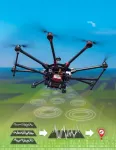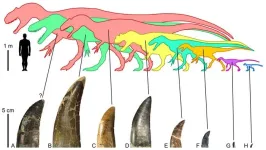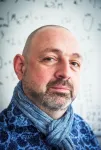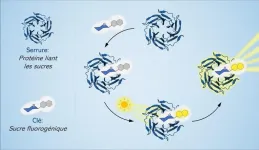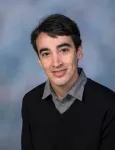(Press-News.org) Images
A new breed of semiconductors that could enable breakthroughs in solar cells and LEDs will benefit from cutting-edge manufacturing approaches, through a new project led by the University of Michigan.
Backed by $3 million from the National Science Foundation, it includes partners at the University of California San Diego.
The effort combines hands-on work that improves upon the process of layer-by-layer deposition of semiconductor materials during production with an information-sharing approach that boosts cooperation between companies while protecting proprietary information and worker interests.
Halide perovskites, a class of materials that has been largely developed over the past decade, represent a promising new semiconductor material that can, among other things, boost solar cell efficiency. How promising? In less than 15 years of study, solar cells utilizing perovskites have increased their efficiency from 10% to 26%.
"What’s amazing is the rapid rate of how perovskites have caught up to silicon," said Neil Dasgupta, U-M associate professor in both mechanical engineering and materials science and engineering, and the principal investigator of the grant. "From a manufacturing standpoint, they can be less energy intensive to process. You can print them almost like an ink onto materials. They're also very tuneable and customizable."
This means perovskites can be optimized to capture different parts of the spectrum. It also means that they may ultimately be cheaper to produce.
Newer technologies like perovskite semiconductors inevitably pit companies against each other in a race to improve performance, streamline manufacturing and bring products to market. But pure competition slows progress down as companies perform similar experiments, covering the same ground.
The U-M-led team will seek to incorporate "federated learning" into the process—an approach that allows multiple entities to feed test results into a predictive model that helps all parties improve their manufacturing process while protecting their trade secrets.
"With something like perovskite manufacturing, you have different sources of data on factors such as the optimal processing parameters," said Raed Al Kontar, U-M assistant professor of industrial and operations engineering. "The question becomes how these different companies that are doing their own research can optimally collaborate and distribute the data they’re collecting through trial and error testing."
Engineers at U-M, and their partners at UCSD, will conduct isolated experiments with perovskite semiconductors. Al Kontar will take data collected from each to build predictive models for forecasting product quality and performance—helping both to narrow down key parameters such as optimal pressure and temperature during manufacturing.
Pooling information in this way allows for faster progress in development and reduces costs. The NSF considers it a form of "cyber manufacturing," which "exploits opportunities at the intersection of computing and manufacturing with the potential to radically transform concepts of manufacturing."
It also couples with Michigan Engineering's people-first approach, ensuring that the solution will be relevant to those working in solar cell manufacturing.
"We're thinking about how we can use technology to make smaller and medium-sized enterprises competitive in the production of these products," said Chinedum Okwudire, U-M professor of both mechanical engineering and integrative systems and design.
To do that, the team has Sarah Crane, research manager at U-M's Economic Growth Institute, and Julie Hui, assistant professor at the School of Information, who studies how technology influences access to work and employment.
"Sarah and Julie will help us make sure we understand the landscape out there for those companies—what their needs are in this space, how we can bring them into this ecosystem and how we can help them create jobs."
In addition to Dasgupta, Okwudire, Al Kontar, Crane and Hui, U-M's team includes Wei Lu, professor of mechanical engineering, who will lead efforts to model the mechanical and material aspects of the process. Partners at UCSD include David Fenning, assistant professor of nanoengineering, who will lead the solar cell testing and design aspects of the project.
The four-year, $3 million grant is part of the NSF's Future Manufacturing program supporting "fundamental research and education of a future workforce to overcome scientific, technological, educational, economic and social barriers in order to catalyze new manufacturing capabilities that do not exist today."
END
$3M to boost state-of-the-art solar manufacturing
An effort led by U-M could enable industrial competitors to collectively build a predictive model that speeds the development of advanced solar cells
2023-11-14
ELSE PRESS RELEASES FROM THIS DATE:
Mount Sinai bioengineers send cardiac muscle samples into space to study heart cell biology in microgravity
2023-11-14
Mount Sinai’s Cardiovascular Research Institute is sending bioengineered human heart muscle cells and micro-tissues into space for the first time on NASA’s 29th SpaceX commercial resupply services mission, which launched Thursday, November 9. The “SpaceX CRS-29” mission is sending scientific research to the International Space Station (ISS), where the samples will stay for approximately 30 days before returning to Earth.
Through this experiment, Icahn School of Medicine at Mount Sinai researchers aim to gain a better understanding of how cardiac muscle cells, or cardiomyocytes, adapt to extreme biological stresses, and how microgravity and other features of ...
Long-term heat tolerance in plants
2023-11-14
Two papers describe the genetic basis of long-term heat tolerance in the model plant Arabidopsis thaliana, with implications for crop breeding. Teruaki Taji and colleagues evaluated dozens of lines of the model mustard weed for both long term (37 °C for 36 days) and short term (42°C for 50 minutes) heat stress. The authors found considerable variation within the species, but little overlap between responses to the two different heat challenges, suggesting that long-term heat stress tolerance is controlled by different cellular mechanisms than the more commonly studied short-term heat stress. Chromosomal mapping using the F2 progeny of a cross between a long-term-heat ...
Health plays a role in older adults’ vulnerability to scams, poll suggests
2023-11-14
Three out of every four older adults say they have experienced a fraud attempt by phone, text, email, mail or online in the last two years, a new poll shows. Three in ten say they’ve been victims of at least one scam.
The poll reveals an especially strong link between an older adult’s health and their vulnerability to scams – both being able to spot one and becoming the victim of one.
Across the board, people aged 50 to 80 who reported being in fair or poor physical or mental health, those with disabilities, and those who rate their memory as fair or poor were more likely than others their age to say they’d experienced ...
New twist on AI makes the most of sparse sensor data
2023-11-14
LOS ALAMOS, N.M., Nov. 14, 2023 — An innovative approach to artificial intelligence (AI) enables reconstructing a broad field of data, such as overall ocean temperature, from a small number of field-deployable sensors using low-powered “edge” computing, with broad applications across industry, science and medicine.
“We developed a neural network that allows us to represent a large system in a very compact way,” said Javier Santos, a Los Alamos National Laboratory researcher who applies ...
Boosting profits for technology holders and licensees through game theory
2023-11-14
Patents and licenses safeguard the intellectual property of the rights holder from being copied or sold without their permission. Companies and individuals who want to make use of the patented or licensed invention must make a formal request to do so. In industries where oligopolies operate—a small number of producers who control the supply of a good or commodity and can determine prices—the profitability of licensing a patent depends on two critical factors: the chosen method of payment for license access and the relative number of firms granted the license as opposed to those left ...
New study reveals surprising insights into feeding habits of carnivorous dinosaurs in North America
2023-11-14
New research sheds light on the dining habits of ancient carnivorous dinosaurs from Jurassic rocks of the USA. A recent scientific study published in PeerJ Life & Environment by Roberto Lei (Università degli Studi di Modena e Reggio Emilia) and colleagues explores the bite marks left on the ancient bones of the giant long-necked sauropod dinosaurs like Diplodocus and Brontosaurus by carnivorous theropod dinosaurs.
Tooth-marked bones provide invaluable insights into the feeding behaviors of long-extinct carnivorous creatures. While it is commonly thought that the giant tyrannosaurs were the primary culprits behind these tell-tale marks on dinosaur ...
Current uses of asbestos exceed exposure limits
2023-11-14
San Francisco, November 14, 2023 – A new study summarizing exposures to asbestos during the installation and removal of asbestos cement products demonstrates that these construction activities almost always exceed U.S. occupational limits. The study focused on airborne asbestos exposures from existing uses of asbestos that are still allowed in most countries.
Average task-specific asbestos exposures during the cutting of asbestos cement pipe were more than 50 times the Occupational Safety and ...
Einstein Foundation Award 2023: The Einstein Foundation Berlin awards €500,000 prize to enhance quality in research
2023-11-14
The €500,000 Einstein Foundation Award for Promoting Quality in Research honors researchers and institutions whose work helps to fundamentally advance the quality and robustness of research findings. The award is bestowed jointly with the QUEST Center for Responsible Research at the Berlin Institute of Health (BIH). “The Einstein Foundation Award is the first of its kind in the world to recognize efforts to improve research quality. Now in its third year, the award shines a spotlight on individuals and projects that exhibit outstanding dedication, but also the ...
Shedding new light on sugars, the “dark matter” of cellular biology
2023-11-14
Scientists at Université de Montréal’s Department of Chemistry have developed a new fluorogenic probe that can be used to detect and study interactions between two families of biomolecules essential to life: sugars and proteins.
The findings by professor Samy Cecioni and his students, which open the door to a wide range of applications, were published in mid-October in the prestigious European journal Angewandte Chemie.
Found in all living cells
Sugar is omnipresent in our lives, present in almost all the foods we eat. But the importance of these simple carbohydrates extends far beyond tasty desserts. Sugars ...
Study sheds light on how Earth cycles fossil carbon
2023-11-14
HOUSTON – (Nov. 14, 2023) – As the primary element of life on our planet, carbon is constantly journeying from living creatures down into the Earth’s crust and back up into the atmosphere, but until recently, quantifying this journey was virtually impossible.
To help unravel the mystery of how the Earth cycles fossil carbon, Rice University’s Mark Torres and collaborators studied the chemistry of a river system extending from the Peruvian Andes to the Amazon floodplains. Together with collaborators from five other institutions, Torres helped show that high rates of carbon breakdown persist from mountaintop to floodplain, ...
LAST 30 PRESS RELEASES:
Exploring how patients feel about AI transcription
Category ‘6’ tropical cyclone hot spots are growing
Video: Drivers struggle to multitask when using dashboard touch screens, study finds
SLU research shows surge in alcohol-related liver disease driving ‘deaths of despair’
Rising heat reshapes how microbes break down microplastics, new review finds
Roots reveal a hidden carbon pathway in maize plants
Membrane magic: FAMU-FSU researchers repurpose fuel cells membranes for new applications
UN Member States pledge to increase access to diagnosis and inhaled medicines for the 480 million people living with COPD
Combination therapy shows potential to treat pediatric brain cancer ATRT
Study links seabird nesting to shark turf wars in Hawai‘i
Legal sports betting linked to sharp increases in violent crime, study finds
Breakthrough AI from NYUAD speeds up discovery of life-supporting microbes
New Eva Mayr-Stihl Foundation funding initiative boosts research at University of Freiburg on adaptation of forests to global change
The perfect plastic? Plant-based, fully saltwater degradable, zero microplastics
Bias in data may be blocking AI’s potential to combat antibiotic resistance
Article-level metrics would provide more recognition to most researchers than journal-level metrics
Satiety’s little helper: Protein that supports appetite regulating protein identified
UF dives deep into predicting storm damage with computer models
A stormy ocean voyage yields insights on the global carbon cycle
Scientists identify first non-coding gene that controls cell size
Demonstration of altermagnetism in RuO₂ thin films -- A new magnetic material for the AI era
Penn researchers awarded $25M to conduct trial using smartphones to fight heart disease
PCORI awards funding for new patient-centered healthcare research
Exploring the origins of the universe: 145 low-noise amplifiers complete ALMA telescopes
Empress cicada wings help illuminate molecular structure
Using sound waves to detect helium
Time burden in patients with metastatic breast and ovarian cancer from clinic and home demands
Researchers discover bias in AI models that analyze pathology samples
Scientists ID potential way to prevent brain injuries from triggering Alzheimer's
MASTER 2nd Open Call: Execution period kick-off
[Press-News.org] $3M to boost state-of-the-art solar manufacturingAn effort led by U-M could enable industrial competitors to collectively build a predictive model that speeds the development of advanced solar cells
